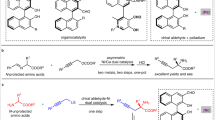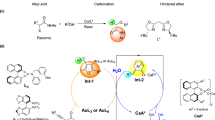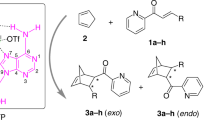Abstract
The enantioselective addition of water to olefins in an aqueous environment is a common transformation in biological systems, but was beyond the ability of synthetic chemists. Here, we present the first examples of a non-enzymatic catalytic enantioselective hydration of enones, for which we used a catalyst that comprises a copper complex, based on an achiral ligand, non-covalently bound to (deoxy)ribonucleic acid, which is the only source of chirality present under the reaction conditions. The chiral β-hydroxy ketone product was obtained in up to 82% enantiomeric excess. Deuterium-labelling studies demonstrated that the reaction is diastereospecific, with only the syn hydration product formed. So far, this diastereospecific and enantioselective reaction had no equivalent in conventional homogeneous catalysis.
This is a preview of subscription content, access via your institution
Access options
Subscribe to this journal
Receive 12 print issues and online access
$259.00 per year
only $21.58 per issue
Buy this article
- Purchase on Springer Link
- Instant access to full article PDF
Prices may be subject to local taxes which are calculated during checkout



Similar content being viewed by others
References
Silverman, R. B. The Organic Chemistry of Enzyme Catalyzed Reactions Ch. 10 (Academic Press, 2000).
Tokunaga, M., Larrow, J. F., Kakiuchi, F. & Jacobsen, E. N. Asymmetric catalysis with water: efficient kinetic resolution of terminal epoxides by means of catalytic hydrolysis. Science 277, 936–938 (1997).
Zhu, S.-F., Chen, C., Cai, Y. & Zhou, Q.-L. Catalytic asymmetric reaction with water, enantioselective synthesis of α-hydroxyesters by a copper-carbenoid O–H insertion reaction. Angew. Chem. Int. Ed. 47, 932–934 (2008).
El-Qisairi, A. Hamed, O. & Henry, P. M. A new palladium(II)-catalyzed asymmetric chlorohydrin synthesis. J. Org. Chem. 63, 2790–2791 (1998).
Alper, H. & Hamel, N. Asymmetric synthesis of acids by the palladium catalyzed hydrocarboxylation of olefins in the presence of (R)-(–)- or (S)-(+)-1,1′-binaphthyl-2,2′-diyl hydrogen phosphate. J. Am. Chem. Soc. 112, 2803–2804 (1990).
Gawron, O. & Fondy T. P. Stereochemistry of the fumarase and aspartase catalyzed reactions and of the Krebs cycle from fumaric acid to D-isocitric acid. J. Am. Chem. Soc. 81, 6333–6334 (1959).
Willadsen, P. & Eggerer H. Substrate stereochemistry of enoyl-CoA hydratase reaction. Eur. J. Biochem. 54, 247–252 (1975).
Agnihotri, G. & Liu, H. Enoyl-CoA hydratase: reaction, mechanism and inhibition. Bioorg. Med. Chem. 11, 9–20 (2003).
Mohrig, J. R. et al. Importance of historical contingency in the stereochemistry of hydratase–dehydratase enzymes. Science 269, 527–529 (1995).
Cornils, B. & Herrmann, W. A. Aqueous-Phase Organometallic Catalysis 2nd edn (Wiley, 2004).
Lindström, U. M. Organic Reactions in Water (Blackwell, 2007).
Noyori, R. et al. Asymmetric hydrogenation of β-keto carboxylic esters. A practical, purely chemical access to β-hydroxy esters in high enantiomeric purity. J. Am. Chem. Soc. 109, 5856–5858 (1987).
Schetter, B. & Mahrwald, R. Modern aldol methods for the total synthesis of polyketides. Angew. Chem. Int. Ed. 45, 7506–7525 (2006).
List, B., Lerner, R. A. & Barbas C. F. Proline-catalyzed direct asymmetric aldol reactions. J. Am. Chem. Soc. 122, 2395–2396 (2000).
Nising, C. F. & Bräse S. The oxa-Michael reaction: from recent developments to applications in natural product synthesis. Chem. Soc. Rev. 37, 1218–1228 (2008).
Vanderwall, C. D. & Jacobsen, E. N. Enantioselective formal hydration of α,β-unsaturated imides by Al-catalyzed conjugate addition of oxime nucleophiles. J. Am. Chem. Soc. 126, 14724–14725 (2004).
Stewart, I. C., Bergman, R. G. & Toste, F. D. Phosphine-catalyzed hydration and hydroalkoxylation of activated olefins: use of a strong nucleophile to generate a strong base. J. Am. Chem. Soc. 125, 8696–8697 (2003).
Roelfes, G. & Feringa, B. L. DNA-based asymmetric catalysis. Angew. Chem. Int. Ed. 44, 3230–3232 (2005).
Roelfes, G., Boersma, A. J. & Feringa, B. L. Highly enantioselective DNA-based catalysis. Chem. Commun. 635–637 (2006).
Coquière, D., Feringa, B. L. & Roelfes, G. DNA-based catalytic enantioselective Michael reactions in water. Angew. Chem. Int. Ed. 46, 9308–9311 (2007).
Boersma, A. J., Feringa, B. L. & Roelfes, G. Enantioselective Friedel–Crafts reactions in water using a DNA-based catalyst. Angew. Chem. Int. Ed. 48, 3346–3348 (2009).
Shibata, N., Yasui, H., Nakamura, S. & Toru, T. DNA-mediated enantioselective carbon–fluorine bond formation. Synlett 1153–1157 (2007).
Fournier, P., Fiammengo, R. & Jäschke, A. Allylic amination by a DNA-diene–iridium hybrid catalyst. Angew. Chem. Int. Ed. 48, 4426–4429 (2009).
Denmark, S. E., Winter, S. B. D., Su, X. & Wong, K.-T. Chemistry of trichlorosilyl enolates. 1. New reagents for catalytic, asymmetric aldol additions. J. Am. Chem. Soc. 118, 7404–7405 (1996).
Heathcock, C. H. Stereodifferentiation addition reactions in Asymmetric Synthesis Vol. 3 (ed. Morrison, J. D.) Ch. 2 (Academic Press, 1984).
Rosati, F. et al. A kinetic and structural investigation of DNA-based asymmetric catalysis using first-generation ligands. Chem. Eur. J. 15, 9596–9605 (2009).
Bahnson, B. J., Anderson, V. E. & Petsko, G. A. Structural mechanism of enoyl-CoA hydratase: three atoms from a single water are added in either an E1cb stepwise or concerted fashion. Biochemistry 41, 2621–2629 (2002).
Berman, H. M. & Schneider, B. in Oxford Handbook of Nucleic Acid Structure (ed. Neidle, S.) 295 (Oxford Univ. Press, 1999).
Nguyen, B., Neidle, S. & Wilson, W. D. A role for water molecules in DNA-ligand minor groove recognition. Acc. Chem. Res. 42, 11–21 (2009).
Acknowledgements
This work was supported by grants from the National Research School Combination – Catalysis, the European Research Area Chemistry program and the Netherlands Organisation for Scientific Research.
Author information
Authors and Affiliations
Contributions
A.J.B., B.L.F. and G.R. conceived the project; A.J.B., D.C. and G.R. designed the experiments; A.J.B., D.C., D.G. and F.R. performed the experiments and analysed the data. A.J.B., B.L.F. and G.R. co-wrote the paper. All authors discussed the results and commented on the manuscript.
Corresponding authors
Ethics declarations
Competing interests
The authors declare no competing financial interests.
Supplementary information
Supplementary information
Supplementary information (PDF 3905 kb)
Rights and permissions
About this article
Cite this article
Boersma, A., Coquière, D., Geerdink, D. et al. Catalytic enantioselective syn hydration of enones in water using a DNA-based catalyst. Nature Chem 2, 991–995 (2010). https://doi.org/10.1038/nchem.819
Received:
Accepted:
Published:
Issue Date:
DOI: https://doi.org/10.1038/nchem.819
This article is cited by
-
PNA as Hybrid Catalyst Scaffold Catalyzed Asymmetric Friedel–Crafts Alkylation
Catalysis Letters (2020)
-
Asymmetric catalysis mediated by a mirror symmetry-broken helical nanoribbon
Nature Communications (2019)
-
Comparing proteins and nucleic acids for next-generation biomolecular engineering
Nature Reviews Chemistry (2018)
-
Site-selective photoinduced cleavage and profiling of DNA by chiral semiconductor nanoparticles
Nature Chemistry (2018)
-
The use of marine-derived fungi for preparation of enantiomerically pure alcohols
Applied Microbiology and Biotechnology (2018)



